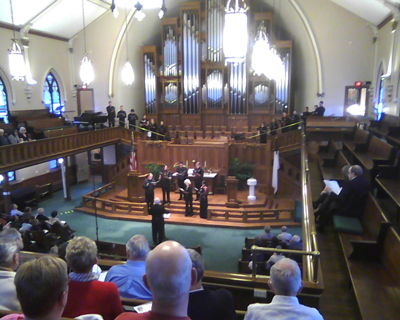by Daniel Hathaway
 Expanding its reach around the region, Ross W. Duffin and Quire Cleveland took their survey of rounds and canons to Painesville United Methodist Church on Sunday afternoon, November 8. “Sing You After Me: Wondrous Rounds & Canons” showed the variety of ways that melodies combined with themselves can produce larger pieces of music. The cleverly-devised program featured two dozen works ranging from the 13th to the 19th centuries in expert performances by Quire’s 19 professional singers.
Expanding its reach around the region, Ross W. Duffin and Quire Cleveland took their survey of rounds and canons to Painesville United Methodist Church on Sunday afternoon, November 8. “Sing You After Me: Wondrous Rounds & Canons” showed the variety of ways that melodies combined with themselves can produce larger pieces of music. The cleverly-devised program featured two dozen works ranging from the 13th to the 19th centuries in expert performances by Quire’s 19 professional singers.
Quire had already sung this program on Saturday evening at St. John’s Cathedral in Cleveland. In Painesville, Duffin took advantage of the church’s altar platform and choir loft stairways to deploy his choral forces in groups that suited each set of pieces. Like a well-choreographed marching band running formations at half-time, Quire moved quickly between each choral tableau, keeping the program moving forward at an agreeable pace.
Rounds and canons come in all flavors and degrees of complexity, and Quire gave its audience a thorough sampling of the repertoire, from treatments of Medieval chant in the Llibre vermell and the Worcester Fragments through the mathematical-musical puzzles embedded in motets by Ciconia, Ockeghem, Févin, Verdelot, and Mouton, to the more transparent secular rounds of 16th- and 17th-century England.
In the latter part of the program, Quire visited more recent canonic pieces by J.S. Bach, Mozart, and Brahms, including a perpetual canon by Bach provided with a charming text by Duffin, and the “Benedictus” from a canonic mass by Brahms that later formed the second movement of the motet Warum ist das Licht gegeben. The last entry was the quartet from Beethoven’s Fidelio, “Mir ist so wunderbar,” in an a cappella choral arrangement that worked beautifully.
As Duffin pointed out in an interview for this publication, not every piece on the program clearly reveals its canonic substructure. The best composers can craft beautiful music without calling attention to the fact that their motet may be made up of a single theme that gets combined with itself forward, backward, and sideways. Ockeghem’s “Agnus Dei” from the Missa Prolationum was an extreme case in point on Sunday.
Other pieces are happy to show how they’re made, like the three Thomas Ravenscroft rounds that ended the first half of the program, or Thomas Arne’s brilliant The Singing Club, which pokes fun at bad singers.
Two pieces on the program enjoy an interesting local connection: Robert Ramsey’s With humble voice O Lord and Orlando Gibbons’ Orlando was his name are only to be found in manuscripts in Case Western Reserve University’s Special Collections Library.
Ross Duffin had a musicologist’s field day putting this program together. That the audience was thoroughly engaged from one end to the other on Sunday was a tribute both to Duffin’s savvy programming and Quire’s skill — and obvious delight — in performing the music. The crowd asked for more at the end, and the singers obliged with a true encore: a reprise of the popular anonymous round Non nobis Domine.
Published on ClevelandClassical.com November 17, 2015.
Click here for a printable copy of this article


